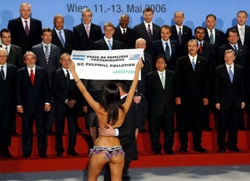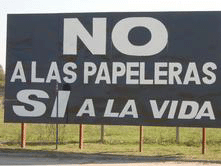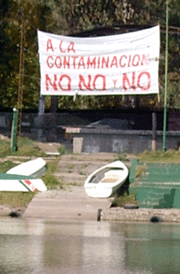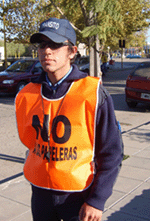Yet as their words ring off brown tile and plastic roses, it is clear that the threat of a papelera, Spanish for paper mill, being built across the river on the Uruguay shore was not an issue they could ignore. Lifelong residents of Gualeguaychú, a town of 80,000 during the tourist season located 3.5 hours north of Buenos Aires, Argentina, the Bargases have jumped into the up swell of community opposition to the papelera construction project. Anna, an attorney, serves on ACAG’s legal team and Oscar works as a community mobilizer. Their message: "You can’t throw us into the trash just because we are out of sight in the South." [1]
The entire eastern side of Gualeguaychú borders the sparkling waters of its namesake river, a tributary of the Río Uruguay, which forms the northernmost border between Argentina and Uruguay. Known for great fishing and beaches, as well as for being the place in Argentina to kick up ones heels during the bawdy, gaudy pre-Lenten Carnival, Gualeguaychú has been catapulted into the media spotlight because of community resistance to Finnish multinational Botnia and Spanish paper giant ENCE’s plans to construct two massive papeleras 25 miles from the town plaza.
Marginalized from the planning process, it was only in September of 2003 that a public assembly was first called in Gualeguaychú to inform residents, as obligated by law, of the corporations’ construction plans near the economically depressed Uruguayan town of Fray Bentos, just across the river. "The underlying assumption was that since European residents didn’t want the papelera built in their backyards, the corporations would find less resistance in South America," Anna says. Oscar adds, "the perception of the global south from the European point of view is that we would be too ignorant to object to this project."
However, the community has resisted. Since December 2004, activists opposed to the papelera have intermittently blocked the bridge which joins the two countries for weeks at a time, using direct action tactics to grind trade and tourism to a halt. On April 30th, 2006, nearly a hundred thousand people rallied on the international bridge crossing to oppose the papelera and demand sustainable development alternatives for struggling small town life.
 One local resident caused a spike in media attention when she took to the international stage on May 12th, 2006 when she appeared at a summit of 60 European and Latin American heads of state in Vienna. Posed as a journalist, "Miss Gualeguaychú," 25-year old Evangelina Carrozo walked bikini-clad across the stage holding a sign that read "No Pulpmill Pollution" in English and Spanish.
One local resident caused a spike in media attention when she took to the international stage on May 12th, 2006 when she appeared at a summit of 60 European and Latin American heads of state in Vienna. Posed as a journalist, "Miss Gualeguaychú," 25-year old Evangelina Carrozo walked bikini-clad across the stage holding a sign that read "No Pulpmill Pollution" in English and Spanish.
An International Relations Fiasco
Previously good neighbors, the papelera has strained relations between Argentina and Uruguay. This is in part due to Botnia’s refusal to stop construction for 90 days during presidential negotiations between President Tabaré Vázquez of Uruguay and Argentina’s Nestor Kirchner. Those negotiations subsequently collapsed. Botnia’s explanation: a halt in construction could hurt stock market prices. [2]
Although Gualeguaychú residents have petitioned the Argentine government repeatedly to take a lead in opposing the papelera, it wasn’t until May 9th, 2006 that President Kirchner stood alongside anti-papelera demonstrators. Anna Bargas comments that politics are so tied up in the economic relationship of Uruguay and Argentina that local residents are skeptical that Kirchner will really be able to have an impact. "It is in his best interest to keep the international bridge open, and he will say whatever he must to keep us from blocking it."
 It’s not just locals who are concerned about the impact of the papeleras. Official complaints submitted by activists and the Argentine government have convinced major funders to rethink their investments. In April 2006, the International Finance Corporation (IFC), a member of the World Bank Group, decided to withhold US$400 million until flawed environmental impact assessments have been reevaluated. [3] Dutch financial service company ING completely withdrew its initial pledge of US$480 million days after the IFC made its decision public. [4] These financial powerhouses, after returning to the environmental impact assessment reports, were left with too many unanswered questions and continued international pressure. While Botnia’s other investors are being pressured to pull out of the project, as of this writing, construction remains on schedule at 30 percent complete with a target deadline of 2007. [5]
It’s not just locals who are concerned about the impact of the papeleras. Official complaints submitted by activists and the Argentine government have convinced major funders to rethink their investments. In April 2006, the International Finance Corporation (IFC), a member of the World Bank Group, decided to withhold US$400 million until flawed environmental impact assessments have been reevaluated. [3] Dutch financial service company ING completely withdrew its initial pledge of US$480 million days after the IFC made its decision public. [4] These financial powerhouses, after returning to the environmental impact assessment reports, were left with too many unanswered questions and continued international pressure. While Botnia’s other investors are being pressured to pull out of the project, as of this writing, construction remains on schedule at 30 percent complete with a target deadline of 2007. [5]
Take It To The Hague
In addition to quality of life issues, the papelera may also be in flagrant violation of international law. On May 4th 2006 Argentina filed a formal complaint with the International Court of Justice (ICJ), the principal judicial body of the United Nations. Argentina argues that Uruguay breached the bilateral "Uruguay River Treaty," signed in 1975, which establishes joint management and natural resource protection of the Uruguay River. [6]
Specifically, the allegation is that Uruguay "unilaterally authorized the construction of a pulp mill without complying with the obligatory prior notification and consultation procedure" mandated by the treaty. The Argentine government further claims that the papelera will "damage the environment of the River Uruguay and its area of influence zone" affecting over 300,000 residents who are concerned with the "significant risks of pollution of the river, deterioration of biodiversity, harmful effects on health and damage to fisheries resources," and the "extremely serious consequences for tourism and other economic interests." [7]
Argentina also filed a request with the ICJ to halt pulp mill construction while the court deliberates. This is the first time a Latin American country has taken a neighboring country to the ICJ over an environmental dispute and also the first time a project initially funded by the World Bank has been under scrutiny there.
Toxic Waters?
 "The Río Uruguay is not big. It has to be dragged regularly and is shallow, only six meters deep in some places and full of sand bars," Oscar Bargas explains. Gualeguaychú residents expressed concern that the pulp mill will use the river as a dumping ground for waste materials.
"The Río Uruguay is not big. It has to be dragged regularly and is shallow, only six meters deep in some places and full of sand bars," Oscar Bargas explains. Gualeguaychú residents expressed concern that the pulp mill will use the river as a dumping ground for waste materials.
Botnia intends to use a pulp bleaching technology known as "Elemental Chlorine Free," a process that reduces but does not completely eliminate the release of dioxins as mill waste. [8] Dioxins are toxic pollutants shown to cause cancer in a variety of forms. Greenpeace and other environmental groups have campaigned against the use of Elemental Chlorine Free products, stating that cleaner non-chlorine bleaching technologies are available. [9] Companies see the cost of cleaner technologies as prohibitive.
The Guaraní Aquifer is fed by the Río Uruguay and is said to contain up to 200 years worth of potable water for every person on earth. The potential for this gigantic water resource to be secondarily polluted by papelera-emitted chemicals is high, and seems an unwise risk in an era where water is heralded as the next oil.
In addition to the pulp bleaching, the raw material the mill plans to use is also worrisome. Eucalyptus trees are notorious water-suckers, each tree gulping 30-35 liters of water per day. "In several years," Oscar Bargas tells us, "the land won’t serve for anything. It will be dried up." As of 2002, Uruguay has more than 450,000 hectares of eucalyptus planted, up from 90,000 in 1990. These tree plantations border other kinds of agricultural fields, which place staple crops such as beans and grains in direct competition with the Eucalyptus for water. The Botnia plant will require 3.5 million cubic meters of wood per year. [10]
The Economics of Labor
Botnia claims in its 2004 publicly available (in English) Environmental Impact Assessment Report, that the massive construction project will increase regional tourism as workers fill local hotels, restaurants, and transportation services. [11] Gualeguaychú residents point out that this claim ignores the devastating loss of tourism from fisherman, beachgoers, and Carnival celebrants who, turned off by smelly air and toxic water, will seek their diversions elsewhere.
Resorting to archaic down-and-dirty marketing techniques, Botnia has essentially bought the opinions of the Fray Bentos residents. The corporation has sponsored the high school soccer team and its logo now appears on their jerseys. Botnia-imprinted notebooks and pens have been donated to the schools and presentations by company representatives have indoctrinated the town council.
Anna Bargas sadly reflects "people in Fray Bentos would rather die of cancer down the road than die of hunger today." Her statement reveals the economic gap between the solvent tourist destination of Gualeguaychú and the more forgotten border crossing of Fray Bentos. Towns located in the global south that lack the community empowerment tools to decide their own development paths often fall prey to corporate industry. Despite the mass mobilization and education campaign by the Gualeguaychú Citizens Environmental Assembly, the reality of poverty in Fray Bentos has provided a prime location for foreign corporations to do as they please.
The Citizens Speak
 Yet hope wears neon orange reflective vests in the streets of Gualeguaychú. A 23 year old transit inspector who declined to give his name wore the ubiquitous "No a las Papeleras" message in bold letters across his work vest while directing traffic. He is one of many government employees using his public post to oppose papelera construction. The vests were purchased by the municipal government using public funds, indicative of the unified support for the movement. Roughly eight out of every ten cars in Gualeguaychú sport a "No a las Papeleras" bumper sticker, and nearly every business in town had a similar poster in their window.
Yet hope wears neon orange reflective vests in the streets of Gualeguaychú. A 23 year old transit inspector who declined to give his name wore the ubiquitous "No a las Papeleras" message in bold letters across his work vest while directing traffic. He is one of many government employees using his public post to oppose papelera construction. The vests were purchased by the municipal government using public funds, indicative of the unified support for the movement. Roughly eight out of every ten cars in Gualeguaychú sport a "No a las Papeleras" bumper sticker, and nearly every business in town had a similar poster in their window.
 Julio Diaz is a waiter at a Mexican restaurant in downtown Gualeguaychú. At 31 years old, he has returned to his hometown after going to college in Buenos Aires and now makes his living from the seasonal influx of taco-hungry tourists. "This community is fueled by tourism from Carnival and people coming to the beaches. They won’t keep coming if there is a papelera next door." He casts a glance around the empty restaurant, its windows adorned with "No a las Papeleras" posters. "If the papelera is built, in ten years Gualeguaychú will be a ghost town." [12]
Julio Diaz is a waiter at a Mexican restaurant in downtown Gualeguaychú. At 31 years old, he has returned to his hometown after going to college in Buenos Aires and now makes his living from the seasonal influx of taco-hungry tourists. "This community is fueled by tourism from Carnival and people coming to the beaches. They won’t keep coming if there is a papelera next door." He casts a glance around the empty restaurant, its windows adorned with "No a las Papeleras" posters. "If the papelera is built, in ten years Gualeguaychú will be a ghost town." [12]
#####
Mneesha Gellman and Josh Dankoff live in Buenos Aires, Argentina. Gellman enjoys pondering conflict mediation while Dankoff has been known to play the clarinet.
Notes:
1. Bargas, Anna and Oscar. Personal Interview by the authors, translated by Mneesha Gellman. May 12, 2006, Gualeguaychú, Argentina.
2. "The Center for Human Rights and Environment files OECD Specific Instance Complaint Against Finish Company Botnia for Violations to OECD Guidelines for Multinational Enterprises in Uruguayan Mills Project." April 18, 2006 press release, found 5-19-06.
http://www.cedha.org.ar/en/more_information/oecd-complaint.php
3. International Finance Corporation (IFC). "Uruguay Pulp Mills IFC Action Plan Based on Findings of Independent Expert Panel." May 6, 2006, found 5-18-06 http://www.cedha.org.ar/en/initiatives/paper_pulp_mills/
4. British Broadcasting Corporation. "Bank caution on Uruguay mill cash." Published April 12, 2006, found 5-10-06. <http://news.bbc.co.uk/2/hi/business/4901918.stm found 5-19-06>.
5. Bank Track. "International Coalition Denounces Calyon of France for its violations to the Equator Principles for its support to Finnish papermill Botnia in Uruguay." May 18, 2006 press release, found 5-19-06. http://www.banktrack.org/?show=news&id=69
6. The Center for Human Rights and Environment. "IFC Papermill Project Drives Argentina and Uruguay to the International Court of Justice: The Crisis Deepens." May 4 2006 Press Release, found 5-18-06.
http://www.cedha.org.ar/en/more_information/pulpmills-haya.php
7. International Court of Justice. "Argentina institutes proceedings against Uruguay and requests
the Court to indicate provisional measures." ICJ Press Release #2006/17, May 4, 2006, found 5-18-06. http://www.icj-cij.org/
8. Botnia Team Environmental Impact Assessment 2004, compiled by Carlos Faroppa and Kaisu Annanla. p. 8. Found 5-18-06. http://www.metsabotnia.com/en/default.asp?path=204;208;517;1021
9. Greenpeace website. "Paper buying for individuals: Go Ancient Forest Friendly." Found 5-17-06. <http://www.greenpeace.org/international/campaigns/forests/solutions/paper-buying-for-individuals Found 5-19-06>.
10. Botnia. p. 11
11. Ibid. p. 69
12. Diaz, Julio. Personal Interview by the Authors, translated by Mneesha Gellman. May 13, 2006, Gualeguaychú, Argentina.
All photos by authors, except for the following:
Bikini protester: http://www.lasegunda.com/images/pandora/green2.jpg found May 22, 2006.
